51 WE Riders
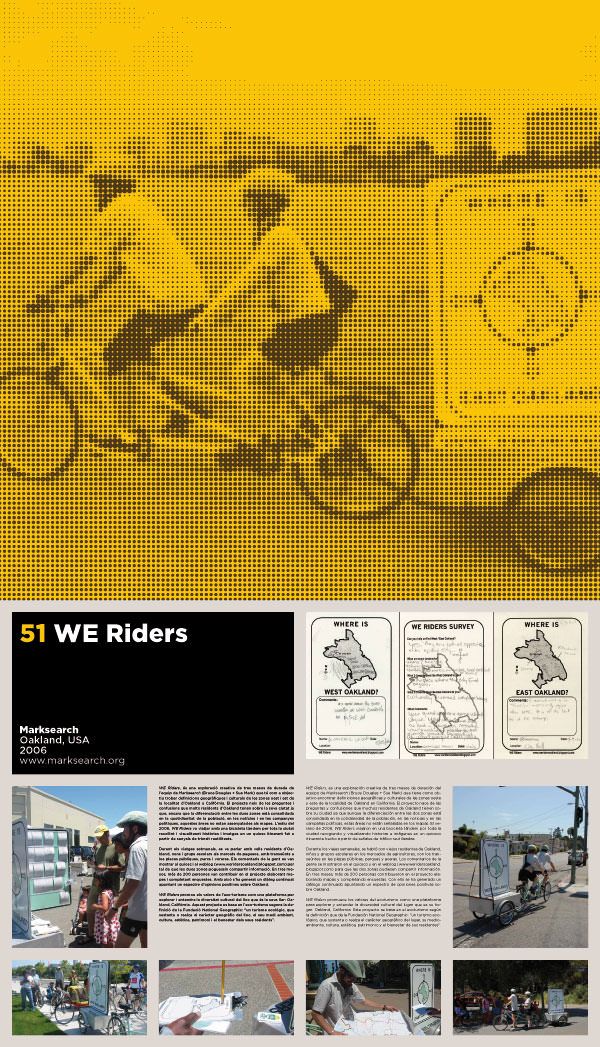 51 WE Riders
51 WE Riders
Marksearch
Oakland, USA
2006
www.marksearch.org
WE Riders, is a three-month creative exploration conducted by the Marksearch team (Bruce Douglas + Sue Mark) which aims to find geographical and cultural definitions in the western and eastern areas of Oakland in California. The project sprang from the questions and doubts raised by many residents in Oakland regarding their city since, although the difference between both areas is consolidated in the everyday life of the residents, these areas do not appear on the maps on the news and in political campaigns. In the summer of 2006, WE Riders rode on a tandem bike across the city collecting and witnessing stories and images in a travelling kiosk made with recycled traffic signs.
During the weekly rides, we spoke with the old residents of Oakland, children and school groups in the farmers’ markets, with passers-by in the public squares, parks and sidewalks. The comments made by the people were hung on the kiosk and on the weblog (www.weridersoakland.blogspot.com) so that both areas could share the information. In three months, over 200 people contributed to the project making maps and filling them in. Thus a dialogue has been built up with continuous additions made regarding positive opinions on Oakland.
WE Riders promotes the values of eco-tourism as a platform to explore and understand the cultural diversity of the place that is home: Oakland, California. This project is based on eco-tourism according to the definition of the National Geographic Foundation: “ecological tourism, which sustains or highlights the geographical character of the place, its environment, culture, aesthetics, heritage and welfare of its residents”.
50 Hangueando-Periódico con Patas
 50 Hangueando-Periódico con Patas
50 Hangueando-Periódico con Patas
Raimond Chaves
El Cerro, Naranjito, Puerto Rico; Berlín; Lima; Barrio
Venecia de Bogotá, Colombia; San Juan de Puerto Rico; Módena; Terrassa; Barcelona; Sevilla; Lleida
2002-2006
www.puiqui.com
This travelling-publishing initiative was carried out from what was sometimes called explicitly a Mobile Station. This station designated the sum of: a) the will to work with others and in various contexts in the places where it reached after being invited as an artist; b) the ability of understanding and agreeing on how this could be used in such meetings; and c) collective building of a temporary space where the public arena could be promoted.
Since the project originated in Puerto Rico, I chose the Splanglish word of Hangueando —from the English to hang around—, a gerund which means being in a place without any predetermined destination. The subtitle of Newspaper with Legs referred to the movement and also the fact that in Peru a “pata” or leg means friend.
HPP (in its Spanish initials) as an almost independent exercise of press provides several editions of publications which vindicated the ability of people to tell their own experiences. Thus in the form of a string newspaper people were invited to reflect on the role of the media, doubts were aired about the limitations and the typical passive role played by readers of the traditional press. An invitation to read the press differently and a suggestion to do it as you want.
Thus, starting from a travelling newsroom which went to places instead of being stationary and using simple domestic equipment (computers, laptops, scanner, A3 printer, digital camera and recorder) it turned the publishing of a newspaper into a public event and reading it into a collective event.
49 Espais, trànsits i dispositius mòvils
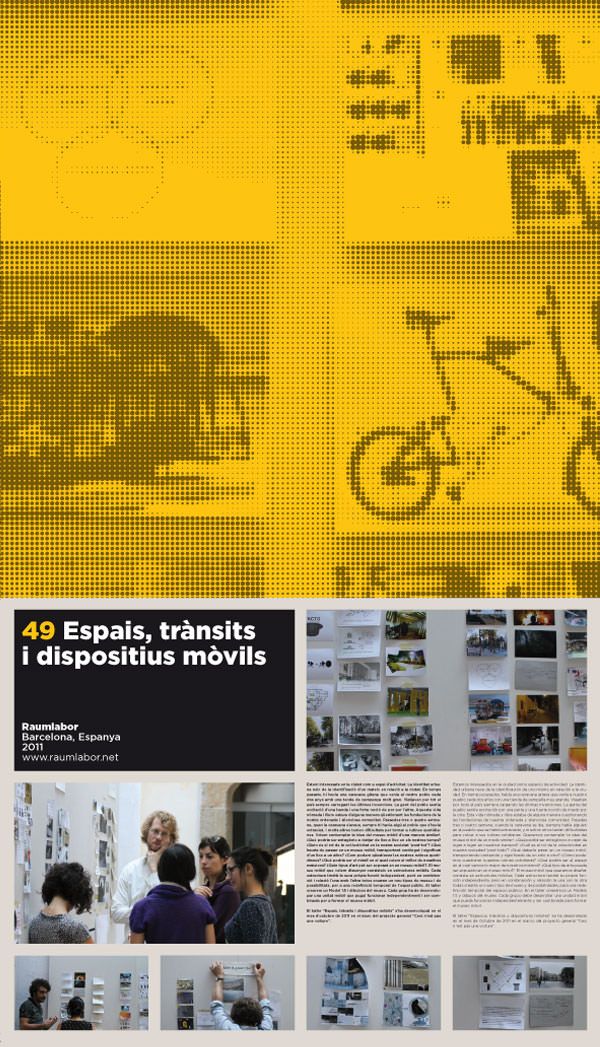 49 Espais, trànsits i dispositius mòvils
49 Espais, trànsits i dispositius mòvils
Raumlabor
Barcelona, Espanya
2011
www.raumlabor.net
We are interested in cities as activity areas. Urban identity is established by the identification of oneself as regards the city. In the past a Gypsy caravan would visit our village every two years with a marquee. They would travel up and down the country loaded with the latest inventions. The locals felt great excitement and also a feeling of great fear. This Nomadic lifestyle of freedom was somehow raising doubts about the foundations of our orderly, silent community. After three or four weeks when the caravan was about to leave, there was always someone who had gone missing, and many others found it difficult to go back to their usual routines. We seek to consider the idea of a mobile museum in the same way! What could be more different than travelling from place to place in our days? What role is played by the group in our ‘post-everything society? What should happen in a mobile museum, transporting contents and meanings from one place to another? How can we doubt our everyday routines? In which mirror could we see the best of ourselves? What kind of art can be exhibited in a mobile museum? The mobile museum we wish to design consists of mobile structures. Each structure will have its own independent function, but combined with and related to one another they can all create new kinds of museums and possibilities, to temporarily redefine public space. At the workshop we will create a model on a 1:5 scale with drawings of the museum. Each group must develop a mobile unit that can function independently and be combined to form the mobile museum.
The workshop “Spaces, travels and mobile devices” took place in October 2011 in the context of the general project “Ceci n’est pas une voiture”.
48 Folk Float
 48 Folk Float
48 Folk Float
Public Works
Egremont, UK
2007
www.publicworksgroup.net
Folk Float is a mobile archive in the city of Egremont.
Its shape and mechanisms were determined by the original archive and due to the expectations of the groups involved in it. The Egremont archive was, and still is, an eclectic collection of objects, artefacts and publications that was collected by an informal network of individuals and which was once stored in a private room. It has never been formalized despite the great interest raised by it and the wish to create a public space to exhibit, explain, discuss, extend and shape it.
We rebuilt an old milk float (an electric vehicle that delivers milk door to door) to incorporate a series of functions that can easily respond to the different situations in which the Folk Float could be involved. The vehicle has a display cabinet for valuable objects, a display window for special themes and temporary donations, a place for tea and coffee and a workshop bench, a projection screen, covered meeting and storage areas, a table of contents of all the features in the archive and a blog to enter new features online.
As an architectural construction, a project like Folk Float offers both a spatial reality that can act in the here and now, a precedent for thought and also for the construction of new kinds of “buildings”, which can respond to a specific local situation —for example, a local history museum—, without having to import architectural models from other places. The ambition of Egremont is to develop a permanent public archive that, thanks to its form and construction, can be propagated through space and time.
47 BASEmóvel ou Conversa como lugar
 47 BASEmóvel ou Conversa como lugar
47 BASEmóvel ou Conversa como lugar
Vitor Cesar
Fortaleza, Brasil
2002-2008
www.vitorcesar.org
Between 2002 and 2004, the Transição Listrada (Renata Costa Lima, Rodrigo Costa Lima and Vitor Cesar) invited people,
presentations and debates to come to BASE, the artists’ workspace in Fortaleza. The space closed down and subsequently the BASEmóvel was born: a flexible structure whose aim is to provide meeting space, conversations and study areas.
The BASEmóvel has been turned into several formats. The first edition held consisted of a series of workshops inside Ceará, as the artists project and how they formed the organization. To carry out the workshops, all the material collected in the two years that BASE existed —a small library, photographs and videos— were made available for consultation. In the second edition, held in collaboration with Graziela Kunsch —an “easy chair for two” which houses a library— was used at the exhibition Campo Coletivo, at the Centro Universitario Maria Antonia.
46 Carrinho multimedia
 46 Carrinho multimedia
46 Carrinho multimedia
Ana Dumas
Salvador, Bahia, Brasil
2009
www.carrinhomultimidia.com
A travelling art and communications centre: an array of ideas, concepts, images, texts, electronic sounds, excerpts from the 21st century. This collage of references of the universe of pop and folk music: coffee trolleys in Bahia, sounds from Jamaica and New York, arte povera, pop art, punk, tropicalism, Socratic philosophy. A travelling gallery, low resolution cinema, a mural that walks, a Nomadic book. The Carrinho Multimidia is the technology of all that’s possible, street technology —if you can’t shoot your idea on film, do it with your mobile phone. The resolution of your idea does not matter, what matters is that you express it, share it, whether the support is digital or analogical—.
With a portable projector, tablet, cordless microphone, LED monitor, a mat for the computer mouse, stickers and posters, the Carrinho promotes performances, free classes, travelling installations, educational activities and marketing.
On the Carrinho Multimidia, languages are there to serve the exchange of information, memories, knowledge. No boundaries or hierarchies between them: a visual concept is worth as much as a textual, verbal or sensorial concept.
45 ¿De parte de quién? Call free
 45 ¿De parte de quién? Call free
45 ¿De parte de quién? Call free
Locutorio Móvil
Josep-Maria Martín
Barcelona, Espanya
2003
www.josep-mariamartin.org
The Project Who’s Calling? Call Free: Mobile Telephone Centre arose from a number of thoughts regarding the proliferation of these telephone centres as a new urban phenomenon related with immigration and cultural movement.
The basis of the project was to create a travelling space which would lead to thought about communication, beyond the phenomenon of immigration. To promote a collective construction with anonymous citizens, a platform which would connect personal experiences and reveal social and urban functions and dysfunctions.
A mobile telephone centre was set up in the form of a caravan, where citizens were invited, on their everyday journeys, to call whoever they wanted, to anywhere in the world and do so free of charge. We asked the users to (voluntarily) convey and share excerpts of their life stories with the artists and thus take advantage of the experience of communicating to create fictional stories and film a video documentary.
The interior design of the caravan enabled dialogues, secrets and debates, etc., to be conveyed, different forms of communication between the users and writers, and the video producer and artist, who directed the project. The writers collected valuable material to create a fictional novel from this singular experience.
44 Orbit
 44 Orbit
44 Orbit
Raumlabor
Friburg, Alemanya
2006-2011
www.raumlabor.net
The orbit is part of an integral strategy headed by the municipal theatre of Friburg which we conducted in the season of 2005/06. The new director, Barbara Mundel, was seeking a new way to define theatre in relation to the city, in the context of great social changes and bearing in mind the public funding cuts applied to culture. The Orbit was established as a place where the city and theatre could highlight their relationship and question new perspectives of the contents in the work produced together.
The project, with renewed themes and contents of Friburg’s municipal theatre, went all over the city to discover places and urban conflicts. The theatre seeks its history in the universe of the city. At the end of the first year, in June 2007, the project landed in the theatre. The Orbit is an expandable space module. It is the size of a container and therefore is easy to transport. The first year it was used as a kiosk, office, workshop, bar, serigraph screen, recording studio, house, research laboratory, greenhouse, discotheque, cinema and a newspaper publishing unit.
Between June 2006 and June 2007 it visited eleven places around Friburg. The journey took us to the outskirts and the centre, we landed in shopping centres, travelled to abandoned airports, moved to recently developed areas and to areas of great development in the 1970s, we visited the new university research departments and an old people’s home. Everywhere we went, the project was exhibited for one month.
We carried out surveys in the city centre with the residents of Friburg asking them about their relationship with the city, how they use it and which places they like to visit or avoid. We asked them about the most typical features and on their personal utopias. The result was the first psychological profile of the city of Friburg.
43 Trailer Talk
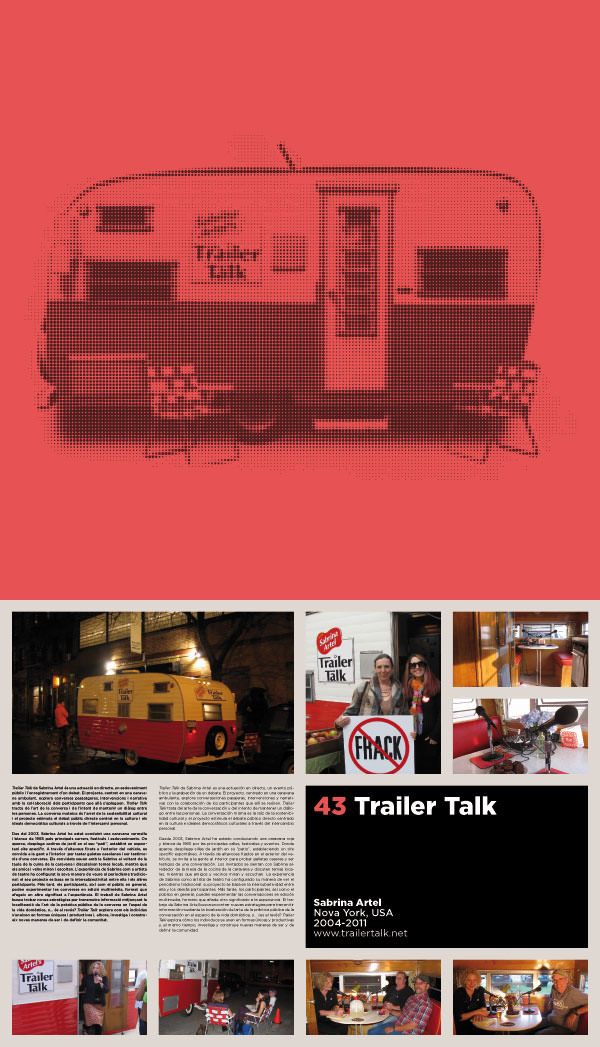 43 Trailer Talk
43 Trailer Talk
Sabrina Artel
Nova York, USA
2004-2011
www.trailertalk.net
Trailer Talk by Sabrina Artel is a live show, a public event and recording of a debate. The project is focused on a travelling caravan that explores passing conversations, interventions and narrative with the help of participants which meet there. Trailer Talk involves the art of conversation and the attempt to hold a dialogue among people. This conversation is the root of cultural sustainability and the project stimulates live public debates focused on culture and cultural democratic ideals by means of personal exchange.
Since 2003 Sabrina Artel has been driving her red and white 1965 trailer through streets, and to festivals and events. Wherever she parks, she unfolds her garden chairs in her “yard”, thus establishing a spontaneous site specific. Over the loudspeakers on the outside of the vehicle, people are invited to come inside and taste homemade cookies and witness a conversation. The guests sit with Sabrina around a kitchen table in the trailer and discuss local issues, while friends and neighbours look on and listen. Sabrina’s experience as a theatre artiste has shaped her way of seeing traditional journalism: her project is based on the inter-subjectivity between her and the other participants. Later, the participants and the general public can experience multimedia edition conversations, a format that adds another meaning to the experience. Sabrina Artel’s work seeks to find new strategies to convey information by means of finding the public art of conversation in the context of domestic life, or... is it the opposite? Trailer Talk explores how individuals come together in unique, productive ways while researching and constructing new personalities and defining the community.
42 CX Simulator
 42 CX Simulator
42 CX Simulator
Felix Mathias Ott
Mataró, Espanya
Projecte no realitzat
www.felixmathiasott.com
The CX Can Xalant Simulator (CX-S) is an unstaged project, designed to take place in the surroundings of the Can Xalant cultural centre. This involves a modified caravan which has been turned into a travel simulator.
We video recorded the caravan’s route from the place it was exhibited across the city and back again to the starting point. This “circular route” was simultaneously shown on five projectors mounted on the windows of the caravan, which enables us to view movement when the caravan is stationary.
With the aid of the video and sound recording of the landscape of public space, the “here and now” of the city could be recorded, and without actually moving, the visitor invited into the CX-S can experiment the travel without any risk of suffering a road accident and without polluting the environment.
The screens show urban scenes, situations and images. By framing these in the simulator, the landscapes are open to interpretation and projection by each of the visitors.
The CX Can Xalant Simulator (CX-S) is interesting since it deals with issues of perception such as, for example, the phenomenon of travel sickness due to the movement occurring because there is a difference between the visually perceived movement and the sense of movement felt by the inner ear. The project is also interesting for providing the chance of experiencing the environment differently and discovering new perspectives which are not seen from other angles.
41 Unofficial
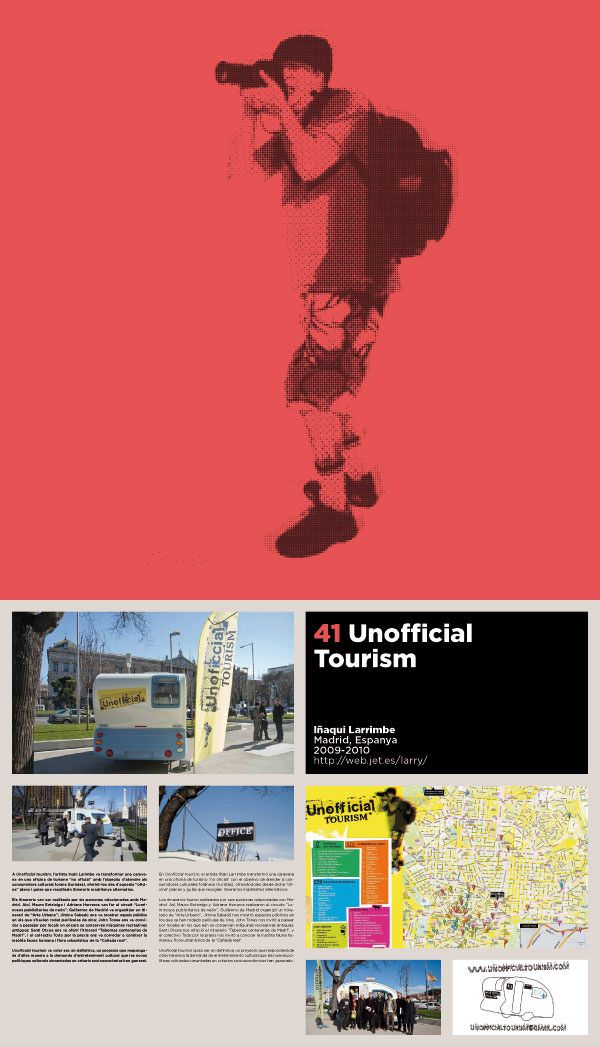 41 Unofficial
41 Unofficial
Tourism
Iñaqui Larrimbe
Madrid, Espanya
2009-2010
http://web.jet.es/larry/
Artist Iñaki Larimbe turned a caravan into an “unofficial” tourist office with the aim of attending the cultural consumers from abroad (i.e. tourists), by offering them plans and guides from this “office” which included alternative routes through Madrid.
The routes were designed by six people who are related to Madrid. Thus, Mauro Entrialgo and Adriana Herreros came up with the circuit “Bright neon advertisements”; Guillermo de Madrid organized an “Urban Art” route; Jimina Sabadú showed us public spaces where films had been shot; John Tones invited us to stroll around places where you can still find old slot machines; Santi Otxoa gave us a route called “Century-old taverns in Madrid”, and the collective Todo por la praxis invited us to become acquainted with the unusual urban human fauna of the neighbourhood called “Cañada real”.
In short, Unofficial Tourism aimed to be a project which responded in another way to the demand for cultural entertainment which the latest cultural policies have created while still anchored to social and economic principles.
40 Kunst
 40 Kunst
40 Kunst
Station Triemli
Public Works
Zurich, Suïssa
2010-2011
www.publicworksgroup.net
Public works has designed a mobile communications space, archive and exhibition which are the basis for Kunst Station Triemli, a public art programme for the Triemli Municipal Hospital in Zurich, Switzerland. For the next ten years, this mobile structure will house and promote an array of creative projects for and with the hospital users.
Kunst Station Triemli comprises five features: a work station that rotates around a fixed archive and a storage unit; a unit with modular panels, rotating shelves, seats and display cabinets; a table with stools which can be stored underneath; a poster; a lectern with a large notebook to write or draw on and a trolley for technological equipment that can work as a pedestal.
For a period of six months an informal Project was conducted to design and exchange the hospital blankets.
Two artists and designers work together to adjust, invent, correct, embellish or help the users, visitors and staff of the hospital to design these blankets. In periods when there was no production, the blankets were displayed to be exchanged or loaned out.
Public works was also invited to carry out the design of the Kunst Station web page. Physical features of the station were used to structure the contents of the digital area.
39 L'Arxivador
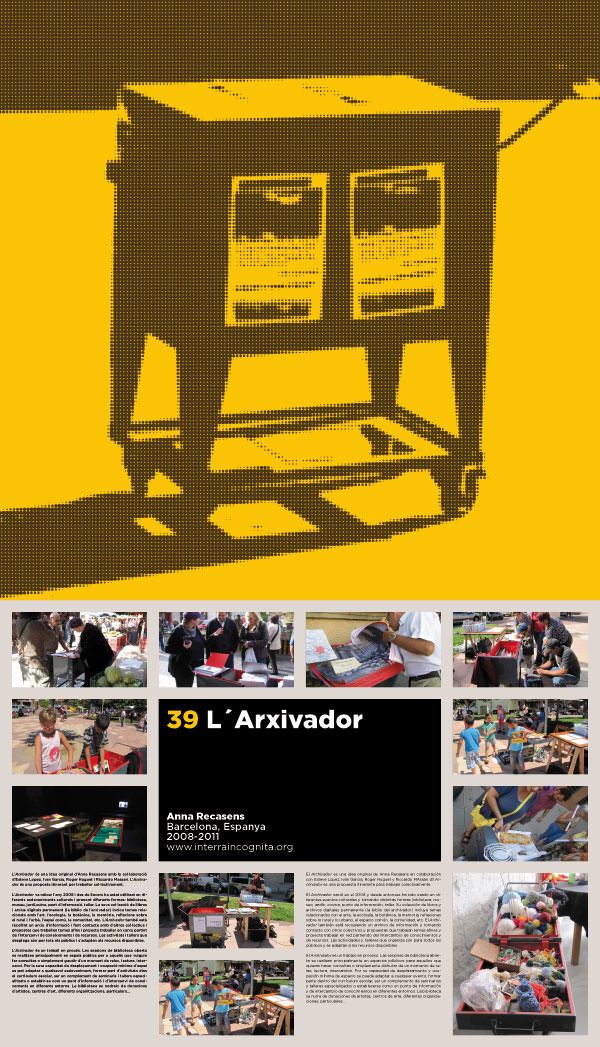 39 L'Arxivador
39 L'Arxivador
Anna Recasens
Barcelona, Espanya
2008-2011
www.interraincognita.org
The filing cabinet is originally an idea by Anna Recasens with the help of Esteve Lopez, Ivan Garcia, Roger Huguet and Riccardo Massari. The filing cabinet is a travelling project used for collective work.
The filing cabinet was established in 2008 and since then has been used at different cultural events and taken on different forms: library, museum, garden, kitchen, information point and workshop. Its permanent collection of books and digital archives (the library of the filing cabinet) includes subjects related to art, ecology, botanicals, memory, thoughts on rural and urban themes, common areas, the community, etc. The filing cabinet is also gathering a data archive and is in touch with other collectives and projects which are working on similar subjects and is scheduled to work within a network based on exchanging know-how and resources. The activities and workshops it carries out are for all ages and public and they adapt to the available resources.
The filing cabinet is a project in progress. The sessions of open library are mainly conducted in public spaces for those who wish to make consultations or simply enjoy a relaxing moment, reading and exchanging. Due to its ability to be transported and since it takes up so little space it can adapt to any event, take part in activities within the school syllabus, be used as a complement at specialized seminars and workshops or be set up as an information point and exchange of knowledge in different contexts. The library exists thanks to donations made by artists, art centres, various organizations, individuals...
38 S.E.F.T.-1
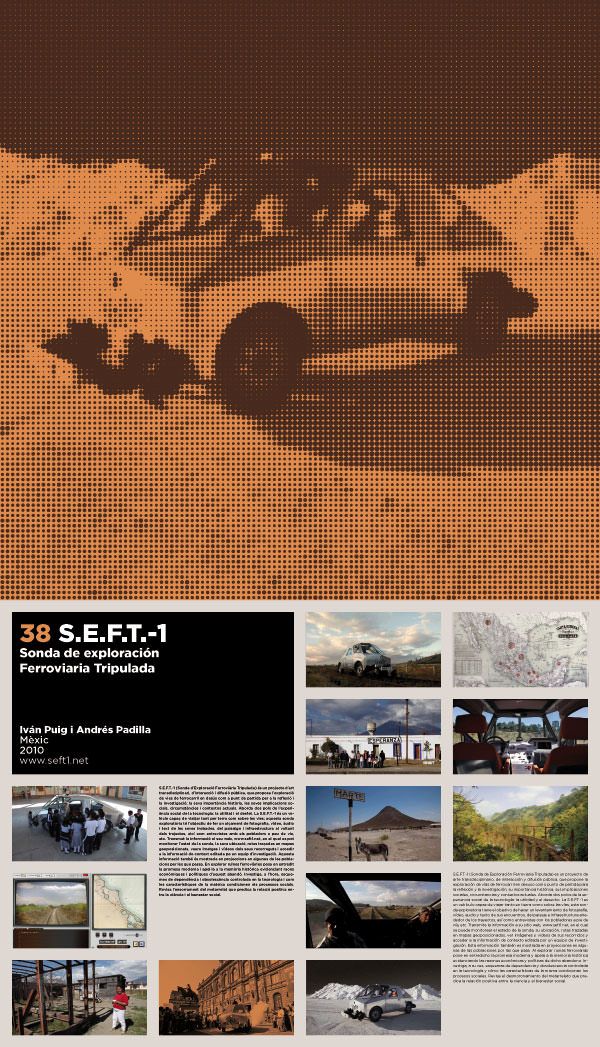 38 S.E.F.T.-1
38 S.E.F.T.-1
Manned Exploration Railway Probe
Iván Puig i Andrés Padilla
Mèxic
2010
www.seft1.net
S.E.F.T.-1 (Manned Exploration Railway Probe in Spanish) is a trans-disciplinary art project, including public interaction and dissemination, which proposes exploring unused railway lines as a starting point for reflection and research; their historical importance, social implications, circumstances and current contexts. It approaches two poles of the social experiment of technology: their usefulness and demise. The S.E.F.T.-1 is a vehicle which is able to travel both overland and on rails; this exploratory probe aims to promote photography, video, audio and text originating from the meetings, landscape and infrastructure around the travels made, as well as interviews with those who settled close to the railway, etc. It transmits data on its website, www.seft1.net, in which one may monitor the conditions of the probe, its location, the routes covered on geo-positioned maps, see images and videos of its travels and access information on the context which is edited by a research team. This information is also shown in some of the towns it passes through. Exploring railway ruins highlights the failure of the promise of modernity and calls on the historical memory by showing the economic and political reasons for its abandonment. It both researches plans of dependency and obsolescence controlled by technology and how its features affect social processes. It reviews the collapse of the meta-story which preaches the positive relationship between science and social welfare.
37 Cronivichana
 37 Cronivichana
37 Cronivichana
Colectivo Descarrilados
Cali, Colombia
2010
http://colectivodescarrilados.blogspot.com
Project held in the context of the Ensayos Públicos # 4 and # 5 at the Art Laboratory of San Agustín, Cuba. A go-kart –the Chivichana- covers the streets of San Agustín carrying generational handbooks. Each handbook includes information on the people that interact with the Chivichana and thus children, youths and adults can explain their lives in relation to the city and their habits.
36 Tren de los curados
 36 Tren de los curados
36 Tren de los curados
Colectivo Descarrilados
La Habana, Cuba
2005
http://colectivodescarrilados.blogspot.com
Art management suggestion selected for the 7 Salón de Octubre (Cali) and the 40 Salón Nacional de Artistas (Bogota). The transporting of train carriages (abandoned and corroded by time) to the neighbourhood streets was the start of nine actions held over thirty consecutive days in homes, the park, corners of the neighbourhood; these carriages became the meeting point for children, youths and older citizens from the area who gave life to Photo of you, Come to the neighbourhood, Mecatearte, The Neighbourhood’s Skin, Parquearte, Memory, Art and Sports, Stories of the Neighbourhood and 7th of August 1956.
35 Canómada
 35 Canómada
35 Canómada
Colectivo Descarrilados
Cali, Colombia
2008-2009
http://colectivodescarrilados.blogspot.com
Project invited to the 41 Salón Nacional de Artistas held in Cali, Colombia in 2008. For two months, the canoe navigated between several villages along the River Cauca, carrying objects and messages which provided poetical relationships among the villagers. Canomadar: Action of navigating –exchanging – inhabiting – indicating – relating – going on trips. The canoe was a register of meetings; the river, a symbol of movement and life.
34 Serenata en las ruinas
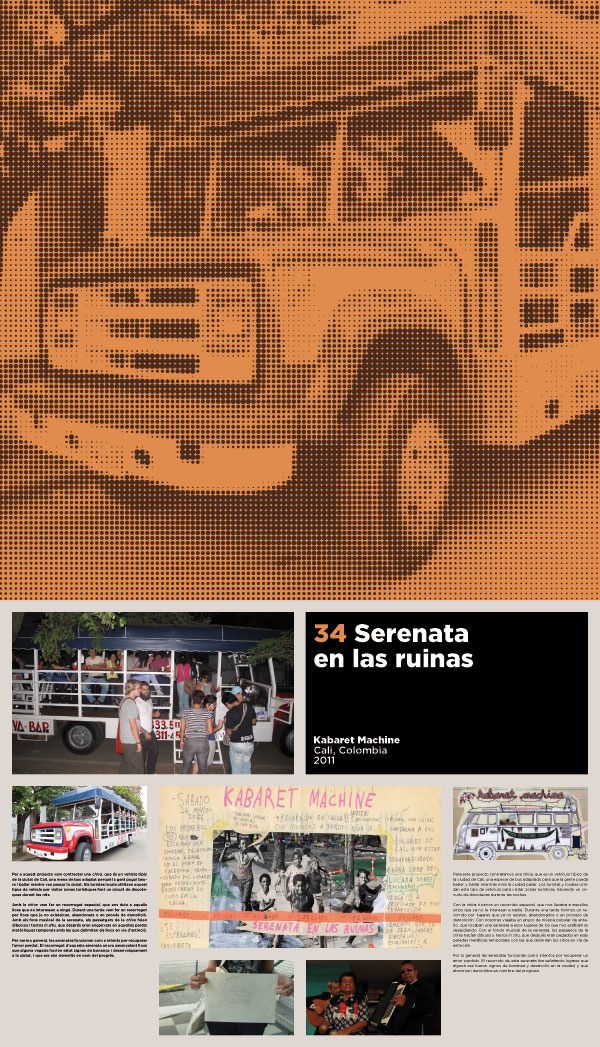 34 Serenata en las ruinas
34 Serenata en las ruinas
Kabaret Machine
Cali, Colombia
2011
For this Project we hired a chiva, which is a typical vehicle in the city of Cali, a kind of bus adapted in such a way that people can drink and dance on it while it passes through the city. The local tourists use this kind of vehicle to visit tourist areas by doing a round of the discotheques at night.
We covered a special route with our chiva, which carried us to those places of no interest to anyone. During one afternoon we passed through places that either no longer exist, are abandoned or in the process of being demolished. With serenades as a musical backdrop, the passengers on the chiva made sketches and penned texts in situ, and which were later hung on those temporary metal fences which are used to fence off these places that are becoming extinct.
As a rule, serenades are used as a way to recover a lost love. The route of this serenade highlighted places that once had been signs of good times and development in the city, and which are now being demolished in the name of progress.
33 Escuela Panamericana del Desasosiego
 33 Escuela Panamericana del Desasosiego
33 Escuela Panamericana del Desasosiego
Pablo Helguera
Mèxic
2003-2011
www.panamericanismo.org
The Pan American School of Anxiety is an independent non profit art project which began in 2003, and aims to create links among the different regions of America based on discussions, performances, workshops, video shows, interventions and short- and long-term collaborations among individuals and organizations. Its main feature consisted of a portable architectural structure in the shape of a rural school in which several activities were carried out. The foldable structure was placed in a van with the aim of travelling overland across the whole hemisphere, from Anchorage, Alaska, to Ushuaia, Tierra del Fuego.
The project’s aim was to contact a wide variety of people and involve them at different levels. By using several strategies, the aim was to start up a dialogue which covered subjects with local interest related with history, ideology and lines of thought of the Americas, as well as cultural and art problems.
The Pan American School of Anxiety responds to the needs of supporting interregional communication among the Spanish- English- and Portuguese speaking Americas, as well as other communities in the Caribbean and elsewhere, providing links beyond today’s commercial and economic exchanges among these regions. The project, which in its physical trips across the hemisphere tried to literalize the same notion of pan Americanism, is inspired on the travel itineraries of many of those who crossed the continent, ranging from explorers, missionaries, scientists, revolutionaries, intellectuals, writers, and so on.
32 Centro Cultural Nomade
 32 Centro Cultural Nomade
32 Centro Cultural Nomade
a77
Buenos Aires, Argentina
2011
www.centroculturalnomade.blogspot.com
El Centro Cultural Nómade és un contenidor portuari en desús transformat en un mòdul flexible que permet múltiples accions en l’espai públic en contacte amb les institucions socials i educatives de cadascun dels llocs per on fa la seva travessia. En pocs metres quadrats nombroses possibilitats d’acció: una biblioteca, una galeria d’art, un teatre i una escola, a través del mobiliari construït especialment amb material reciclat provinent d’embalatges de la indústria automotriu.
Aquesta proposta s’encadena amb un seguit d’accions i intervencions anteriors desenvolupades per a77, que prengueren com a objectiu l’acostament de l’art, l’urbanisme i l’arquitectura a diferents comunitats a través de l’estímul de les seves capacitats artístiques i creatives, el foment de la seva participació en decisions sobre projectes urbans i culturals reals, i el missatge de la reutilització i el reciclatge amb l’objectiu d’incorporar-lo amb imaginació a la vida de tots els dies.
El concepte del reaprofitament de recursos no sols opera com una matèria global de l’actual auge de la sostenibilitat —moltes vegades banalitzat des de la seva incorporació a les estratègies de la societat de consum— ; és pot ser una entrada d’identitat a valorar com a part de la nostra pròpia idiosincràsia.
El Centro Cultural Nómade està realitzant en aquests moments activitats artístiques i culturals per a la comunitat en el seu recorregut per Buenos Aires amb l’objectiu primordial de desenvolupar i implementar estratègies culturals d’accés i inclusió social dirigides a habitants de la històricament postergada zona sud de la ciutat.
